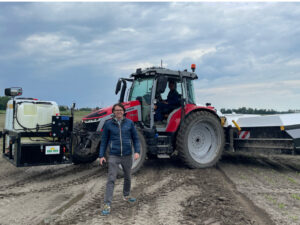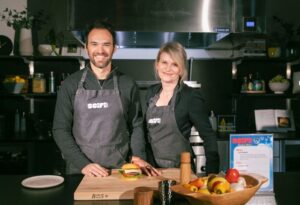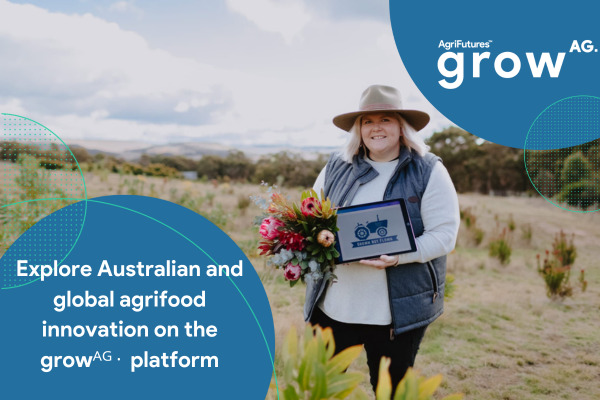The Mixing Bowl convened in Mountain View, California, this week to discuss how IT innovation is transforming the food and agriculture industry.
The opening panel — consisting of a consultant, two journalists, an academic, and a food company representative — presented their thoughts on the key challenges facing the food and agriculture industry today.
Rob Trice, co-founder of The Mixing Bowl and moderator, insisted we need to move beyond discussing the need to feed 9 billion people by 2050 — that has been repeated ad nauseam in pitches, speeches and presentations for several years now — and focus the conversation at FOOD IT on those people injecting change and agility into the food and agriculture sectors now, today, to meet future challenges.
Naomi Starkman, founder of Civil Eats, the online publication dedicated to shifting the conversation around sustainable agriculture, argued that the world already produces enough food to feed itself, but it’s failing to distribute it properly and too much is going to waste.
Starkman, a former farmer herself, also emphasized the need to invest in distribution, aggregation, transportation, and refrigeration “totally un-sexy areas,” and the importance of scaling up sustainable farming.
Food waste was mentioned by Fernando Martins, lead agribusiness partner of Bain & Company, who linked it to the length of supply chains globally.
“The longer the supply chains, the bigger the waste,” he said. “The biggest challenge facing agriculture is how the world feeds Africa. The continent imports a lot of food which is a strain on government financing and is not sustainable. If African farmers can increase their yield to just 50% of what they are in the US, that would make Africa a net exporter of food, and self-sustaining.”
Jennifer Mason, technology & science strategy officer at Mars said that the global food company was there were 101 species of food crops in Africa that were being “neglected by science.” Work is being done to sequence the genomes of these “orphan crops” to teach scientists to breed and plant them on the continent to be more nutritious and weather-resistant, she told the audience. (I found the African Orphan Crops Consortium online, which Mars has invested $2 million in, and UC Davis is supporting alongside Google.)
For Paul Noglows, executive producer of Forbes Media, and organizer of this week’s Forbes AgTech Summit, the main challenge facing the food and ag industries, is also the main opportunity: how do we embrace, fund and adopt innovation?
“Forbes believes entrepreneurial capitalism will be the solution and I’m amazed by the amount of innovation that’s coming through, but there’s not enough communication between startups who are focusing on similar problems,” he said.
More conversation between startups would promote the development of more suitable and adoptable technologies, instead of a wave of similar technologies for farmers to sift through, understand, and then hopefully adopt, he argued. “A grower’s vision rarely goes further than the border of his farm so there has to be more collaboration to come up with solutions that work for everyone,” he said.
How to ensure the right startups receive funding for the amount of time it takes them to get to market was another area of conversation, as Land O’Lakes‘ CIO Michael Macrie spoke from the audience about the technology adoption cycle in agriculture. It took 30 years for farmers to adopt much of the biotechnology that was developed in the second green revolution, and while the next adoption cycle is expected to be shorter at 15 years, that’s still longer than most venture capitalists are willing to wait to get their returns.
And lastly, how to use technology to meet changing consumer preferences was another key challenge highlighted by the panel. Starkman said that the industry needs to increase “truth, transparency and trust” in the food system.
“The current industrial food system has removed us from how we grow our food,” she said, but as consumers start demanding more information, major food companies are waking up and are having to move quicker than food regulators to improve their practices, such as McDonalds’ antibiotics in meat policies, she added.
Justin Siegel, faculty director, innovation institute for food & health, UC Davis, said the technology was there to give consumers what they need in terms of taste and nutrition using bioinformatics and engineering, but consumers need to have the appetite to push this technology forward.
How technology could be used to solve the issue of consumers seeking instant gratification from food at the expense of their health, was another question posed by Bain’s Martins.
SnapDNA, a startup manufacturing handheld devices to test food for disease, won the day’s ‘Golden Blender Award’ after pitching against a mix of indoor agriculture, food traceability, and farm management technologies Athena Intelligence, Avolved, Byte, Edenworks, FreshSurety, Maiaki, and Monj.
And then a collaborative design challenge brought together groups of attendees to come up with technological solutions to the following questions:
- How might IT help farming meet changing societal demands?
- How might we use IT to make food literacy more pervasive in food service?
- How might we use IT to create a smart cattle ranch of the future?
- How might we create an “internet of food?”
- How might IT be used to support the business success of smaller food producers?
This unique design exercise had farmers, investors, technologists, and foodies collaborating with one another to address these challenges. They developed solutions to the questions ranging from cheaper, widely distributed sensor networks, to a Pokemon-style game for food education, to farmers owning and selling their data. But even just the effort and experience from this exercise was a positive experience and outcome, according to Trice.
How would you approach the above questions? Get in touch on [email protected].














Sponsored
Sponsored post: The innovator’s dilemma: why agbioscience innovation must focus on the farmer first